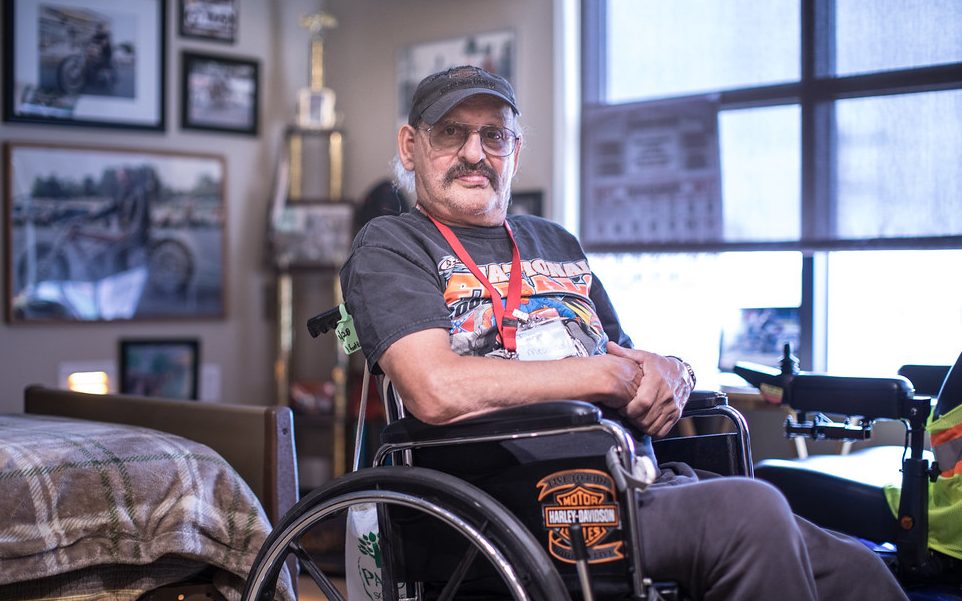This spring, we’ll release “Innovating Michigan Healthcare: Lessons from Funding Technology in Health Since 2015,” an in-depth report on how the Health Fund is supporting technology-based projects. Our series “Tech Tuesdays” reveals some of our stories from the field—examples of Health Fund grantees incorporating technology in noteworthy and effective ways.

University of Michigan
Home-based Transitional Telecare for Recently Hospitalized Older Veterans
2016 Healthy Aging Grant Round
Returning home from the hospital after a medical emergency can be a challenging time, especially for older adults. Many find themselves relieved to be home but daunted by the lengthy recovery process. Given these challenges, older adults often end up back in the hospital. In fact, according the National Institutes of Health, nearly one-fifth of Medicare patients are readmitted within 30 days. These readmissions are often less the result of their initial illness than the deficits that accrue during and immediately following the hospital stay, often referred to as post-hospital syndrome.
The issues that many older adults face after hospitalization are especially tough on older veterans. While a network of services is provided to Michigan’s older veterans through the VA, their service to their country means that they often face complex medical conditions and social situations in their everyday lives—issues that demand more aggressive approaches to post-hospital care.
One Health Fund grantee is addressing readmission rates among Michigan’s 314,000 aging veterans by using technology to help them avoid and ameliorate post-hospital deficits in cognitive and physical functioning. The team at the University of Michigan (U-M) leading the Home-Based Transitional Telecare project is helping recently discharged older veterans address medication issues, avoid in-home risks, and return to their pre-hospital-stay selves, while demonstrating important findings about how clinicians can effectively use telehealth-enabled tablets and wearable sensors with this population.
Research demonstrates the importance of communication after a hospital stay. Unfortunately, traditional home care personnel often lack knowledge of the medical history of a patient and have limited communication with the discharging hospital physician and primary care provider. The U-M project leverages an experienced consultation team, called the Link Team, to serve as a connection between the patient, their caregiver, the home care staff, as well as VA Ann Arbor Healthcare System (VAAAHS) providers.
This person-centered approach leverages virtual video technology, such as with a tablet or cell phone, to give the Link Team another set of “eyes and ears” once the veteran is home. For example, the Link Team’s clinical pharmacist asks patients to see all of their pill bottles, bottle by bottle, allowing the pharmacist to identify medication errors and adherence problems.
Seeing inside the home helps the care team do more than manage medications; they can see other factors that may be complicating the recovery process and preventing the patient from getting enough physical activity at home. The Link Team includes a social worker who has identified potential fall risk situations, such as where a pet in the home may be causing a problematic interaction. The social worker assists with caregiver support, education, and connecting the older adult to resources in the community.
“The virtual video interface in the home helps problem solving for caregivers and patients that you can’t do on the phone,” explains Co-Principal Investigator Christine Cigolle MD, U-M faculty and physician scientist at the VAAAHS Geriatric Research, Education and Clinical Center (GRECC). “This technology helps the patient, helps caregivers, and helps clinicians see the context in which they are operating.”
Beyond successfully using video technology to improve communication, this project investigates how wearable sensors can support post-hospital care. Based on evaluation at the time of home discharge, patients with potential to improve their mobility and physical activity are provided a plan and coaching that is beyond standard home healthcare. The U-M team, under the direction of Co-Principal Investigator U-M faculty and VAAAHS GRECC Director Neil Alexander MD, uses the video technology to implement a home-based physical activity plan designed to enhance mobility gains at home.
A key part of the home program was to evaluate standard consumer technology used to improve physical activity, including a pedometer and wrist-based devices such as the Garmin Vivofit. Early results suggest that these consumer devices are not appropriate for this very frail and disabled patient group. “This population is very sedentary, and they often walk more slowly and differently than the more healthy,” says Alexander. “Wrist-based devices in particular did not work very well.”
Instead, a more sensitive and reliable tool, a research-grade device called the ActivPal, is placed on the thigh and worn 24/7. This provides a method for veterans to focus on improving their lifestyle without having to focus on the technology being used to provide feedback for their physical activity. Although consumer devices are less expensive, the project team made the important discovery that the more advanced activePAL is necessary to provide the quality of physical activity data useful for with more disabled and sedentary veterans. This finding is critical ensure future veterans heading back home from the hospital get the care they need.
